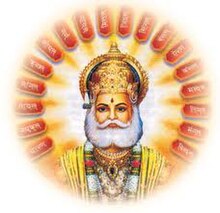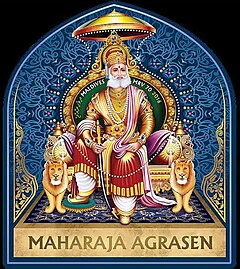Agrasen, most commonly known as Maharaja (literally, great king) Agrasen, was a legendary Indian king of Agroha, a city of traders in the district of Hisar, Haryana. He is a descendant of the Hindu deity, Shri Ramchandra's elder son, Kush. He is credited with the establishment of a kingdom of traders in Northern India named Agroha, and is known for his compassion in refusing sacrificial slaughter of animals in yajnas. Goddess Mahalakshmi bestowed prosperity for him and his descendants.[1]
| Agrasen | |
|---|---|
| Maharaja | |
 | |
| Predecessor | Maharaja Vallabhsen |
| Successor | Shail |
| Consort | Nandini |
| Issue | Vibhu |
| House | Raghuvansham |
| Dynasty | |
| Father | Maharaja Vallabh |
| Mother | Bhagwati Devi |
The Agrawals, a community of traditional traders from northern India, regard Maharaja Agrasen as their forefather and a historical figure who established the foundations of their community in the Kingdom of Agroha.[2] In fact, the term Agrawal means "descendants of Agrasen" or "people of Agroha".
The occasion of his birth anniversary called Agrasen Jayanti is celebrated in the Indian states of Haryana, Punjab, Rajasthan, and Uttar Pradesh where it is recognized as a public or a gazetted holiday.[4][5][6][7] The Government of India in 1976 commemorated the 5100th birth anniversary of Maharaja Agrasen by issuing a postage stamp depicting him, [8][9][10] and so did Maldives in 2016 as a tribute to the contributions of the Agrawal community, a prominent business group in India, in the growing trade relationship between the Maldives and India.[3] The eastern wing of the modern day Agroha Dham temple is dedicated to Maharaja Agrasen, serving as a significant cultural and heritage center for the Agrawal community.[11]

History
editBharatendu Harishchandra (1850-1885), a renowned Agrawal author and poet regarded as the father of Hindi literature and theatre, compiled the legend of Maharaja Agrasen in his 1871 essay Agarwalon ki Utpatti ("Origins of Agrawals and Agrahari"). Drawing from tradition and ancient texts, particularly Sri Mahalakshmi Vrat Ki Katha ("The Story of the Fast for Goddess Mahalakshmi"), he documented Agrasen's story. He stated that Sri Mahalakshmi Vrat Ki Katha was contained in the Bhavishya Purana, which exists in several recensions. However, some researchers were unsuccessful in tracing this text.[14]
In 1976, the Agrawal historian Satyaketu Vidyalankar published a copy of the Mahalakshmi Vrat Ki Katha in his Agrwal Jati Ka Prachin Itihas ("Ancient History of the Agrawal caste"). He stated that he had found this copy in the personal library of Bharatendu Harishchandra.[15]
Legend
editAgrasen was a Kshatriya king of the Sūryavaṃśi dynasty who adopted the Vanika dharma for the benefit of his people. He was the ruler of Khandavprasth, Ballabhgarh, and Agr Janapada (present-day Delhi, Ballabhgarh, and Agra).[16][17]
According to Bharatendu Harishchandra's account, Maharaja Agrasen was born on 15th September 3082 BC,[18] or in 4250 BC on the first day of Ashvin Shukla Paksha,[19] in the last stages of Dvapara Yuga, or the beginning of Kali Yuga. He was the eldest son of Sūryavaṃśi Maharaja Vallabhsen and Queen Bhagwati Devi of Pratapnagar (in present-day Rajasthan) and the elder brother of Shursen.[16][18] Maharaja Agrasen was a 34th-generation descendant of the lineage of Lord Rama's elder son, Kush. At the age of 15, Agrasen fought in the Mahabharata war alongside the Pandavas. Lord Krishna proclaimed that Agrasen would be a yug purush, or "man of the age," and an avatar in the Kali Yuga.
Marriage to Madhavi
editHe was married to Madhavi, the daughter of the serpent king Nagaraja Kumud, with whom Indra was also smitten. When she chose Agrasen as her husband, Indra, the lord of thunderstorms and rain could not bear her loss and created a drought in Pratapnagar. The famine in Agrasen's kingdom forced him to go to war against Indra, but sage Narada brokered peace.[16]
Agrasen's Austerities
editMaharaja Agrasen went to the city of Kāshi and performed intense tapasya (austerity) for the welfare of his subjects. Pleased with his devotion, Lord Shiva advised him to perform tapasya for Goddess Lakshmi.[19] Goddess Lakshmi, pleased with his selfless austerities, granted him a boon: “Establish a new kingdom and, while following the principles of Kshatriya dharma, nurture and protect your kingdom and subjects! Your kingdom will always be filled with wealth and abundance.” Goddess Lakshmi is the kuldevi of (many) Agrawals.[20]
Agrawal Gotras
editPer Bharatendu Harishchandra, the Agarwals are organized into seventeen and a half gotras (exogamous clans), which came into being from seventeen and a half sacrifices performed by Agrasen. The last sacrifice is considered "half" because it was abandoned after Agrasen expressed remorse for the violent animal sacrifices. Bharatendu also mentions that Agrasen had 17 queens and a junior queen, but does not mention any connection between these queens and the formation of the gotras. Neither does he explain how sacrifices led to the formation of the gotras.[21]
Historically, due to regional differences there has been no single unanimous list of these seventeen and a half gotras. In 1983, The Akhil Bhartiya Aggarwal Sammelan, a major organization of Agrawals (also Baranwals), ratified a list of Agarwal gotras.[22] To avoid classification of any particular gotra as "half", the Sammelan provides a list of following 18 gotras:[23]
- Garg
- Goyal
- Kucchal
- Kansal
- Bindal
- Dharan
- Singhal
- Jindal
- Mittal
- Tingal
- Tayal
- Bansal
- Bhandal
- Nangal
- Mangal
- Airan
- Madhukul
- Goyan
| Gotra | Original Gotra | Lord | Sage (Rishi) | Veda | Branch | Sutra |
|---|---|---|---|---|---|---|
| Airan/Aeron | Aurva | Indramal | Atri/Aaurva | Yajurveda | Madhyadini/Madhuri | Kaatyayni |
| Bansal | Vatsya | Virbhan | Vashishth/Vatsa | Samaveda | Kouthmi/Kauttham | Gobhil |
| Bindal or Vindal | Vashishth | Vrinddev | Yavasya or Vashishtha | Yajurveda | Madhuri | Kaatyayni |
| Bhandal | Dhoumya | Vasudev | Bhardwaj | Yajurveda | Madhyadini or Madhuri | Kaatyayni |
| Dharan or Deran | Dhanyas | Dhavandev | Bhekaar or Ghaumya | Yajurveda | Madhuri | Kaatyayni |
| Garg or Gargeya | Gargasya | Pushpadev | Gargacharya or Garg | Yajurveda | Madhuri | Kaatyayni |
| Goyal, Goel or Goenka | Gomil | Gendumal | Gautam or Gobhil | Yajurveda | Madhuri | Kaatyayni |
| Goyan, Gangal | Gautam | Godhar | Purohit or Gautam | Yajurveda | Madhyadini or Madhuri | Kaatyayni |
| Jindal | Jaimini | Jaitrasangh | Bruhaspati or Jaimini | Yajurveda | Madhyadini or Madhuri | Kaatyayni |
| Kansal | Kaushik | Manipal | Kaushik | Yajurveda | Madhyadini or Madhuri | Kaatyayni |
| Kuchhal, Kuchchal | Kashyap | Karanchand | Kush or Kashyap | Samaveda | Kosami or Kauttham | Komaal |
| Madhukul/ Mudgal | Mudgal | Madhavsen | Aashvalayan/Mudgal | Rigveda/Yajurveda | Saalaya/Sakalya | Aslayin |
| Mangal | Maandav | Amritsen | Mudragal/Mandavya | Rigveda/Yajurveda | Sakalya | Asusai |
| Mittal | Maitreya | Mantrapati | Vishwamitra/Maitreya | Yajurveda | Madhyadini/Madhuri | Kaatyayni |
| Nangal/Nagal | Nagendra | Narsev | Kaudalya/Nagendra | Samaveda | Kouthmi/Kauttham | Aslayin |
| Singhal/Singla | Shandalya | Sindhupati | Shringi/Shandilya | Samaveda | Koyumi/Kauttham | Gobhil |
| Tayal | Taitireya | Tarachand | Saakal/Taitireya | Yajurveda/Kri | Madhyadini/Aausthambh | Kaatyayni |
| Tingal/Tunghal | Taandav | Tambolkarna | Shandilya/Tandya | Yajurveda | Madhyadini/Madhuri | Kaatyayn |
The list does not include several existing clans such as Kotrivala, Pasari, Mudgal, Tibreval, and Singhla.[25][need quotation to verify]
See also
editReferences
edit- ^ "HISTORY & PRINCIPLES OF MAHARAJA AGRASEN JI". Akhil Bhartiya Agrawal Sangathan. Retrieved 4 July 2024.
- ^ "Maharaja Agrasen". Agroha Vikas Trust | Agroha Dhaam India. Retrieved 26 October 2024.
- ^ a b "Maldives issues special postage stamp on Maharaja Agrasen". Economic Times. 1 October 2016. Archived from the original on 24 May 2021. Retrieved 27 October 2024.
- ^ "Government of Punjab, Department of Personnel" (PDF). Notification from Government of Punjab, Department of Personnel. 15 December 2023. Archived (PDF) from the original on 7 October 2024. Retrieved 27 October 2024.
- ^ "Haryana Government, Department of Human Resources, Notification" (PDF). Haryana Government, Department of Human Resources, Notification. 22 December 2023. Archived (PDF) from the original on 15 March 2024. Retrieved 27 October 2024.
- ^ "Government of Rajasthan, The General Administration Department Notification" (PDF). 9 October 2023. Archived (PDF) from the original on 29 May 2024. Retrieved 27 October 2024.
- ^ "2024 Public Holiday Calendar | Government of Uttar Pradesh | India". Retrieved 27 October 2024.
- ^ "Maharaja Agrasen Dak Ticket Samaroh ki kuchh Yaden, Omprakash Agrawal, Agradhara, Sept 2016, p. 32" (PDF). Archived from the original (PDF) on 22 February 2017. Retrieved 22 October 2018.
- ^ "KCR Praises Vaisyas to Skies, Says The Community Knows Art of Life". Archived from the original on 26 September 2014.
- ^ India, Post of (1976), English: Stamp, retrieved 27 October 2024
- ^ "Agroha dhaam". Agroha Vikas Trust | Agroha Dhaam India. Retrieved 26 October 2024.
- ^ "Agrasen Ki Baoli". AgrasenKiBaoli.com. Retrieved 4 August 2015.
- ^ Mittal, J.P. (2006), History of Ancient India (4250 BC to 637 AD) page 675, ISBN 978-81-269-0616-1 (This author considers King Agrasen an actual historical figure)
- ^ * Babb, Lawrence A. (2004). Alchemies of Violence: Myths of Identity and the Life of Trade in Western India. SAGE. p. 199. ISBN 978-0-7619-3223-9.
- ^ Babb 2004, p. 199.
- ^ a b c Bhartendu Harischandra. Agarwalon Ki Utpatti Bhartendu Harischandra.
- ^ "About Maharaja Agrasen – Maharaja Agrasen Medical College, Agroha (Haryana)". Retrieved 27 October 2024.
- ^ a b "About Maharaja Agrasen – AGROHADHAM". Retrieved 27 October 2024.
- ^ a b Sharma, Yatendra (2020). THE GREAT KING (SAMRAT) AGRASEN MAHARAJ (Founder of Agrawal Community) A Brief Introduction (PDF) (2020 ed.). Perth, Australia: Shri Ram Katha Sansthan Perth (Inc), Australia. Archived (PDF) from the original on 19 May 2021. Retrieved 27 October 2024.
- ^ "Agarwālā | Indian Caste, Social Hierarchy & Endogamy | Britannica". www.britannica.com. Retrieved 27 October 2024.
- ^ Babb 2004, pp. 201–202.
- ^ Babb 2004, pp. 193–194.
- ^ Babb 2004, p. 192.
- ^ "Agarwal Gotra and Details - Aggarwal Samaj".
- ^ Babb 2004, p. 193.
External links
edit- Maharaja Agrasen at agrasen.com

